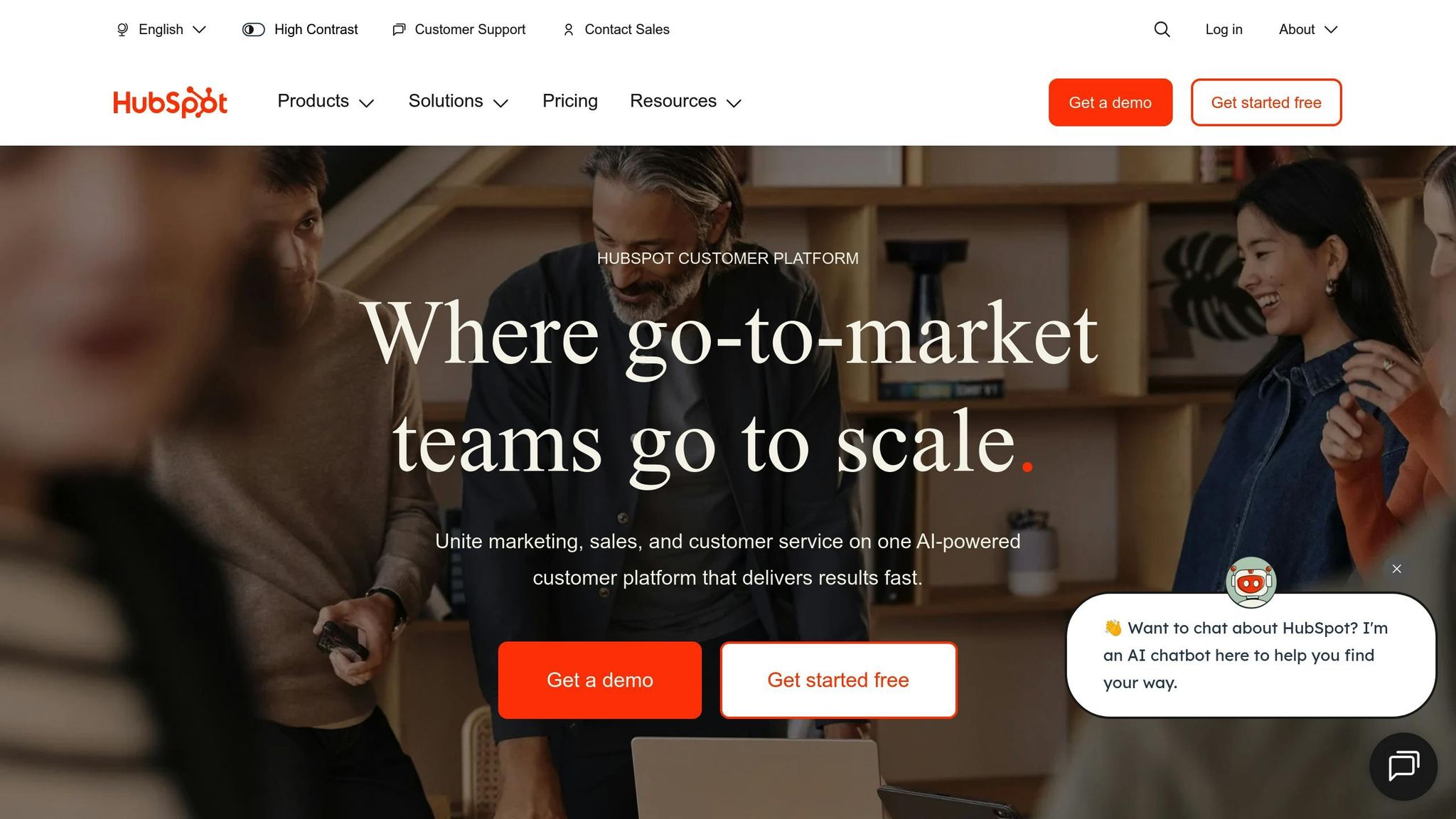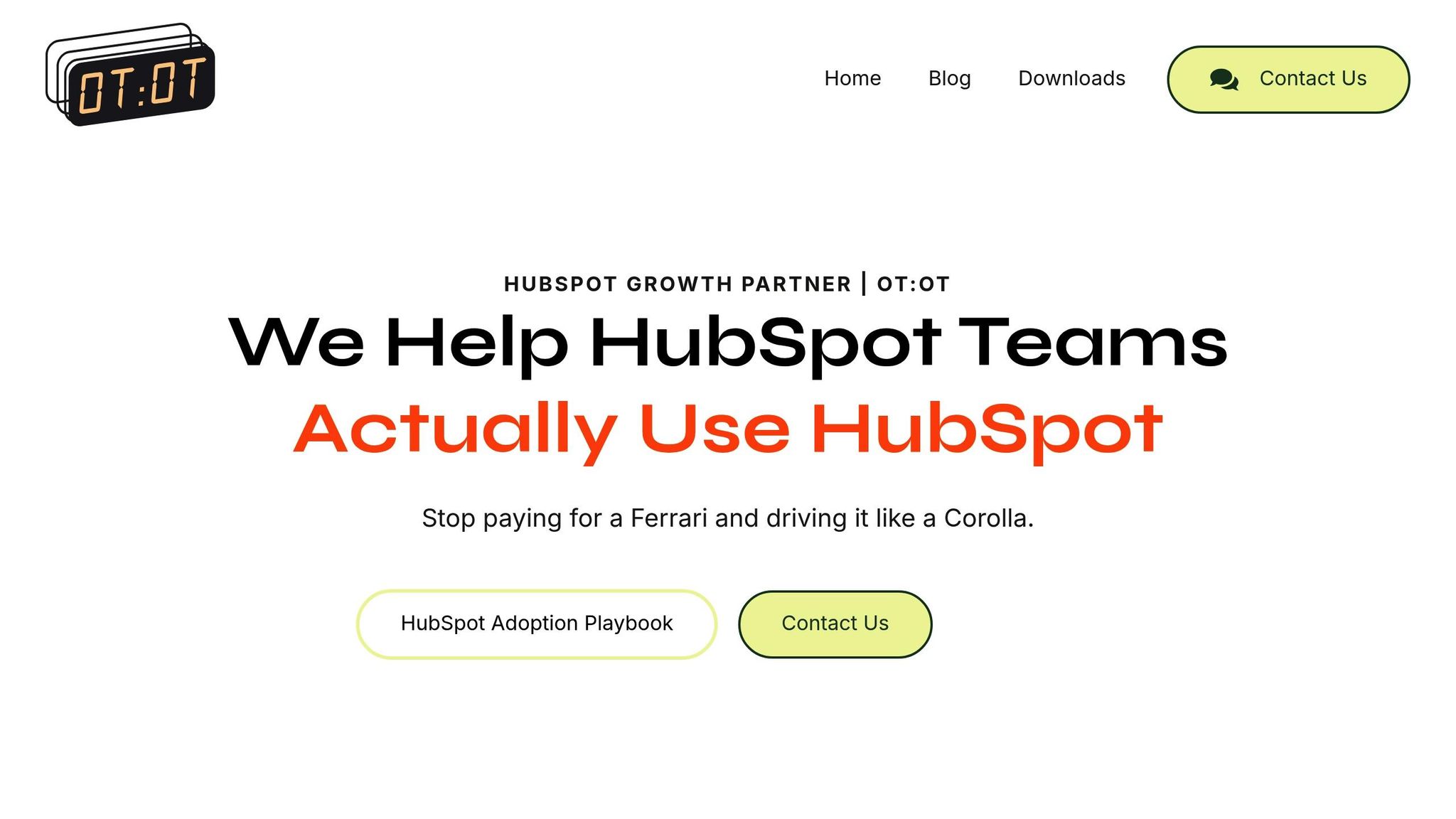How To Build Real-Time KPI Dashboards in HubSpot
Want to track your business performance in real time? HubSpot’s KPI dashboards let you visualize critical metrics like sales revenue, lead conversion rates, and customer satisfaction - all updated automatically. This guide explains how to create dashboards that are accurate, easy to use, and tailored to your business goals.
Key Takeaways:
- Real-time dashboards turn raw data into visual insights (e.g., charts, graphs) that update automatically.
- HubSpot supports up to 30 reports per dashboard and integrates with external systems for a unified view.
- Focus on actionable KPIs like deal win rates, campaign ROI, or ticket resolution times - avoid vanity metrics.
- Use HubSpot’s automation tools to schedule updates and ensure data consistency.
- Customize dashboards for different stakeholders, from executives to team managers.
Quick Steps to Get Started:
- Define KPIs tied to your business goals (e.g., sales pipeline, lead quality).
- Create a dashboard in HubSpot’s Reporting section.
- Add and configure reports with real-time updates and filters.
- Assign permissions based on roles and automate sharing for regular updates.
- Regularly review and refine your dashboards to keep them relevant.
For advanced needs, experts like OT:OT can help optimize data models, clean up inconsistencies, and improve dashboard reliability. This ensures your HubSpot dashboards stay accurate and actionable as your business grows.
Choosing and Defining Key Performance Indicators (KPIs)
How to Select the Right KPIs for Your Business
A successful dashboard starts with KPIs that directly connect to your business goals. Without this connection, you may end up with visually appealing charts that don’t actually help you make better decisions or improve outcomes.
To begin, align your core objectives with measurable results. For example, in sales, focus on metrics like deal win rate, average deal size, and sales cycle length. For marketing, track lead-to-customer conversion rates, campaign ROI, and traffic sources. When it comes to customer service, monitor ticket resolution time, CSAT (Customer Satisfaction Score), and first response time.
Be cautious of "vanity metrics" - numbers that look good but don’t lead to actionable insights. Instead, choose KPIs that drive decisions and encourage specific improvements. Once you’ve identified the right KPIs, tailor them to meet the needs of different stakeholders.
Matching KPIs With Stakeholder Requirements
Different stakeholders require different levels of detail and focus. Executives often need high-level metrics like revenue growth, customer acquisition costs, and lifetime value to inform strategic decisions. In contrast, managers often need more granular data to guide their teams effectively.
For example, sales managers benefit from metrics that provide visibility into their pipeline and team performance. They need to track individual rep performance, deal progress through various stages, and early indicators of potential issues.
Marketing managers focus on campaign performance, lead quality, and attribution data. These insights allow them to pivot strategies quickly based on what’s working. Meanwhile, customer service managers rely on real-time data like ticket volumes, resolution times, and escalation patterns to ensure consistent service levels.
Involving stakeholders early in the KPI selection process is key. Ask them what decisions they frequently make and what data would help them act faster or more effectively. This collaborative approach ensures the dashboards are practical tools used regularly, not just decorative assets.
Customizing KPIs for Specific Business Needs
Once KPIs are aligned with stakeholder needs, adapt them to reflect your unique business operations. Tools like HubSpot allow for custom metrics, enabling you to track industry-specific data that standard templates might overlook. For instance, a SaaS company could create custom fields to monitor product usage, while a manufacturing business might track production milestones. Ensure these customizations integrate seamlessly with your existing data systems.
OT:OT works closely with organizations to design KPIs and data models tailored to their processes. Instead of relying on generic templates, their strategic approach helps businesses pinpoint the most relevant metrics for their unique challenges.
You can also combine data from CRM systems, customer support, and product usage to create comprehensive KPIs, such as a customer health score. Regularly reviewing and refining your KPIs is essential as your business evolves. In fact, companies that align their KPIs with business goals are 42% more likely to reach those objectives.
How to create HubSpot KPI tracking reports in 2025

Setting Up and Customizing Dashboards in HubSpot
Once you've nailed down your KPIs and aligned with stakeholders, it's time to dive into creating and fine-tuning real-time dashboards in HubSpot.
Creating Dashboards in HubSpot
Start by heading to the Reporting section in HubSpot and selecting Dashboards. Click on the "Create dashboard" button to begin. You’ll have two options: use a pre-built template for a quick setup or start from scratch if you need something tailored specifically to your KPIs.
When naming your dashboards, aim for clear, concise titles that reflect their purpose and audience. For example, an executive-level dashboard might be called something like "Executive Summary – November 2025", while a departmental dashboard could be more specific, such as "Marketing Lead Generation – Q4 2025." Remember, the language you choose for the dashboard name will remain fixed, even if shared with users operating in different language settings.
Once your dashboard is named and created, you can start adding the reports that matter most to your team.
Adding and Configuring Reports
With your dashboard set up, the next step is to populate it with reports that showcase your key metrics. HubSpot allows up to 30 reports per dashboard (and a maximum of 100 reports per portal), so it’s essential to prioritize the most critical data.
To add a report, click "Add report" and either select an existing one or create a new one. Be sure the data sources align with your real-time needs. For example, use US formatting (MM/DD/YYYY) for date ranges and set filters to focus on specific segments like sales regions, product categories, or individual team members.
Organize your reports logically. Place the most important KPIs at the top for quick access, and group related metrics together - like keeping all sales data in one section and marketing metrics in another. This structure makes it easier for your team to find what they need without digging through unrelated information.
Enable auto-refresh for your reports to ensure the data stays current throughout the day. For real-time dashboards, automatic updates are a must so that metrics like daily sales numbers or lead generation stats are always up to date.
Once your reports are in place, you can take it a step further with advanced customization to make your dashboard even more actionable.
Using Advanced Customization Options
HubSpot’s advanced features, like conditional formatting and filters, can help you highlight trends and focus attention where it’s needed. Conditional formatting allows you to use color-coding - green for metrics that exceed targets, red for those falling short - making it easy to spot patterns or issues at a glance.
Strategically applied filters can create tailored views for different teams. For example, you can filter by sales rep, pipeline stage, or region, so executives get a high-level overview while managers zero in on their team’s performance.
Stick with visualizations that are easy to interpret, such as bar charts, line graphs, and pie charts, and avoid overly complicated visuals that might confuse your audience. You can also set up automated alerts to notify your team of critical changes, like a sudden drop in deal velocity or a spike in customer support tickets.
Make sure all financial data is displayed in US dollars, using the "$" symbol and proper formatting (e.g., $1,000.00). Numbers should include commas for thousands and periods for decimals. Consistently use the MM/DD/YYYY date format and, when applicable, use imperial units (like miles or pounds) to match US business standards.
For a more comprehensive view, consider integrating data from external systems. HubSpot’s native integrations and third-party plugins let you pull in real-time data from CRMs, marketing platforms, and analytics tools. This creates dashboards that unify data across departments, giving your team deeper insights and a clearer picture for decision-making.
HubSpot’s flexibility, combined with tools like OT:OT for tailored data models, ensures your dashboards can go beyond standard capabilities to meet your specific needs.
sbb-itb-14d4def
Setting Up Real-Time Data Integration and Automation
Real-time dashboards are only as effective as the data feeding into them. To make the most of your HubSpot KPI dashboards, it's crucial to have systems in place that automatically pull in fresh data and keep everything aligned.
Automating Data Updates in HubSpot
HubSpot’s automation tools make it easy to keep dashboards current through scheduled report refreshes. You can configure these updates to occur hourly, daily, or weekly, depending on how frequently your data changes and how critical it is for your team to have up-to-date insights.
This automated feature also simplifies sharing updates. For instance, sales teams can receive daily performance summaries at 9:00 AM EST, while marketing teams might get weekly campaign updates every Monday morning. This eliminates the need for team members to manually check dashboards, ensuring everyone stays informed on key metrics without extra effort.
Additionally, workflows can be set up to trigger updates based on specific events like deal stage changes, lead scoring updates, or ticket resolutions. These workflows can automatically refresh custom properties, sync data between objects, and push the latest information into your dashboard reports.
To ensure consistency, make sure all automated reports adhere to US formatting standards. Once your updates are running smoothly, you can expand your dashboard’s capabilities by integrating data from external sources.
Connecting External Data Sources
For a complete view of performance, most businesses rely on data from multiple platforms. HubSpot supports this need by offering integrations with external systems through native connectors, APIs, and third-party middleware.
- Native integrations connect seamlessly with platforms like Google Analytics, Salesforce, and popular e-commerce tools.
- API connections allow you to pull data from virtually any system that supports data exports.
- Third-party middleware can standardize data formats and manage sync timing, helping to address challenges like inconsistent date formats, currency conversions, and API rate limits that might disrupt real-time data flows.
When connecting external sources, consider data latency and sync schedules. Some integrations refresh every few minutes, while others might only update hourly. Match your dashboard refresh settings to these schedules, and set up alerts to notify your team if syncs fail or deliver unexpected results.
These integrations lay the groundwork for more advanced data architecture improvements.
Improving Data Architecture With OT:OT

Seamless data integration is only part of the equation - your dashboards also depend on a solid data architecture. While HubSpot’s built-in features cover many needs, complex businesses often require tailored solutions for real-time dashboards.
This is where OT:OT comes in. They specialize in customizing HubSpot’s data models and architecture to meet unique operational requirements. Their services include custom object mapping, optimizing data flows, and ensuring dashboards update in real time - crucial for organizations moving from traditional CRM systems to all-encompassing customer platforms.
- Custom object mapping helps businesses track metrics that don’t fit HubSpot’s standard structure. For example, a manufacturing company might need to monitor equipment maintenance schedules, while a subscription business might require revenue recognition models that update as billing cycles complete.
- Optimized data flows ensure information moves smoothly between systems, avoiding delays or bottlenecks. This involves designing integrations that can handle frequent updates, multiple connections, and complex business logic.
- Transitioning from traditional CRM systems often means rethinking how data flows across your organization. OT:OT helps design architectures that support real-time decision-making across all departments, rather than keeping data siloed within individual teams.
For businesses juggling multiple data sources, strict compliance requirements, or intricate reporting needs, working with experts ensures your dashboards remain accurate, scalable, and flexible as your data demands grow.
A clean data architecture also prevents common issues like duplicate records, inconsistent formatting, or unexplained fields that can undermine dashboard reliability. By streamlining your setup, your team can focus on leveraging insights rather than fixing data problems.
Dashboard Permissions, Sharing, and Optimization
Once your HubSpot dashboards are set up and integrated with the necessary data, the next step is to ensure they remain effective and secure. This means setting the right permissions, sharing dashboards efficiently, and keeping them optimized over time.
Setting Permissions and Sharing Dashboards
HubSpot provides a flexible permission system that lets you control who can view, edit, or manage your dashboards. This is especially crucial when dealing with sensitive information like financial data or strategic KPIs that are only meant for specific teams.
Permissions can be customized in your dashboard settings. For example, sales managers might need full editing rights to tweak dashboards for their teams, while sales reps could have view-only access to their individual metrics. Similarly, customer service supervisors may require permissions to manage support dashboards, allowing them to add or adjust reports as needed.
To maintain consistency, ensure all reports follow US formatting standards: MM/DD/YYYY for dates, 12-hour AM/PM for time, and currency displayed as $1,000.00.
HubSpot also offers automated sharing options, which can save time and effort. You can schedule daily or weekly updates to be sent to stakeholders, ensuring they receive the latest insights without the need for manual distribution.
For businesses with complex team structures, periodic permission audits are a must. As roles shift and teams grow, these reviews help prevent outdated access that could compromise data security.
Optimizing Dashboards for Long-Term Success
Dashboards that aren't maintained tend to lose their relevance and reliability over time. To keep them useful, regular optimization should be part of your workflow.
Start by conducting periodic reviews and cleaning up outdated data. For instance, if your company shifts its focus from lead volume to lead quality, your marketing dashboard should reflect this by prioritizing metrics like conversion rates and lead scores instead of just traffic numbers.
HubSpot’s usage analytics can also provide valuable insights. If certain KPIs or reports are consistently ignored, it might be time to reevaluate their importance or adjust how they’re presented. Sometimes, a simple change - like switching from a line chart to a gauge - can make the data more actionable.
To ensure team-wide adoption, provide clear documentation and training. Easy-to-follow guides on interpreting metrics and taking action based on them can transform dashboards from static reports into tools that drive decision-making.
For businesses aiming to continuously refine their dashboards, expert guidance can help align these efforts with broader growth strategies.
Working With OT:OT for Continuous Improvement
As your business evolves, so will your dashboard requirements. This is where specialized support can make a real difference.
OT:OT is dedicated to helping organizations get the most out of HubSpot by embedding processes, training, and safeguards that encourage consistent dashboard use. They tackle common challenges like teams defaulting back to spreadsheets, dealing with inaccurate forecasts, or abandoning dashboards that no longer feel reliable.
Their approach focuses on aligning your dashboards with your business’s changing needs - not just fixing technical issues. For example, as companies move from basic CRM setups to more comprehensive platforms, dashboards often need to expand to include metrics like customer success rates, support ticket trends, and interdepartmental collaboration indicators.
For organizations navigating complex data systems or compliance requirements, OT:OT can customize HubSpot’s data models to ensure scalability. Their expertise helps make dashboard optimization a regular, proactive practice rather than a reactive scramble during a crisis.
Conclusion: Key Steps for Building Real-Time KPI Dashboards
Creating effective real-time KPI dashboards in HubSpot involves more than just assembling reports. It requires a structured approach that aligns your dashboards with strategic goals and ensures they remain useful and trustworthy over time.
Core Steps to Success
Start by defining KPIs that align with your business objectives. Collaborate with stakeholders from different departments to ensure the metrics are meaningful and actionable. For instance, sales teams might focus on metrics like deal pipeline and win rates, while marketing teams may prioritize campaign ROI and lead generation.
Once your KPIs are established, create a new dashboard in HubSpot's Reporting section and add relevant reports. Tailor the visualizations - bar charts work well for pipeline stages, while line graphs are great for tracking trends. This customization enhances clarity and helps stakeholders quickly interpret the data.
To make your dashboards truly dynamic, integrate real-time data. Enable automated updates within HubSpot and connect external data sources, ensuring everyone has access to the latest performance metrics. Don’t forget to format dates as MM/DD/YYYY and display currency as $1,000.00 for consistency.
Next, configure permissions and sharing protocols carefully. Assign access levels based on roles - sales managers may need full editing rights, while team members might only require view-only access to their specific metrics.
However, technical setup alone isn’t enough. Trust in the data is key. A common pitfall is dashboards that go unused due to a lack of confidence in the data. Issues like duplicate entries, missing fields, or unclear labels can quickly erode trust and engagement.
Ongoing maintenance and optimization are essential to keeping dashboards relevant. Regularly review your data, clean up outdated information, and adjust metrics to reflect evolving business priorities. For example, if your focus shifts from lead volume to lead quality, update your marketing dashboard to spotlight conversion rates and lead scores instead of just traffic numbers.
How OT:OT Can Support Your HubSpot Journey
While HubSpot provides robust dashboard tools, navigating complex business needs often requires specialized expertise. This is where OT:OT can make a difference. They address a common challenge - dashboard abandonment - by focusing on the processes that build trust in the data. Their approach goes beyond technical fixes, offering training and practical strategies to ensure consistent dashboard use across teams.
OT:OT’s expertise in customer data modeling and architecture allows businesses to extend HubSpot’s capabilities beyond its standard features. This is especially valuable for companies evolving from basic CRM setups to more advanced platforms that demand dashboards capable of tracking complex metrics.
For organizations managing intricate data systems or strict compliance requirements, OT:OT provides the expertise needed to create scalable dashboards that adapt to changing business needs. Instead of a scenario where “an agency sets up the platform and leaves it to drift,” OT:OT fosters ongoing partnerships to ensure your dashboards continuously deliver actionable insights.
Their goal is simple but powerful: to help businesses achieve clean data, trusted dashboards, and accountable workflows. By doing so, they transform HubSpot from a basic tool into a platform that drives revenue and becomes an integral part of daily decision-making for your teams.
FAQs
How do I choose the right KPIs for my HubSpot dashboard to ensure they drive meaningful actions?
To choose the right KPIs for your HubSpot dashboard, focus on metrics that align closely with your business objectives and offer actionable value. Steer clear of vanity metrics - like total website visits - that may look appealing but don’t contribute to meaningful decision-making. Instead, zero in on KPIs like conversion rates, customer retention, or revenue growth. These metrics provide a clearer picture of your performance and can help shape strategic decisions.
It’s important to regularly revisit and adjust your KPIs to ensure they remain in sync with your goals and respond to changing business priorities. This approach keeps your dashboards relevant, enabling your team to track progress effectively and make smarter, data-driven choices.
How can I integrate external data sources into my HubSpot dashboards for a more complete view of my KPIs?
To bring external data sources into your HubSpot dashboards, you have a few options: custom API connections, third-party integrations, or HubSpot's data sync features. These tools make it possible to pull in data from other platforms, giving you a unified view of your key performance indicators (KPIs) all in one place.
If your business has specific data needs, customizing your HubSpot data model and architecture might be the way to go. Experts like OT:OT specialize in creating tailored solutions, ensuring smooth integration and a more complete dashboard experience that aligns perfectly with your goals.
How can I personalize HubSpot dashboards to meet the needs of different teams or stakeholders?
To make your HubSpot dashboards more effective for different teams or stakeholders, focus on building customized views that showcase the most relevant KPIs for each group. Leverage filters and custom properties to narrow down the data, so stakeholders only see information that aligns with their specific responsibilities and objectives.
Arrange widgets thoughtfully to make crucial insights easy to spot, and tweak the layout to emphasize the most important metrics. This approach ensures that every stakeholder gets tailored, actionable data that helps them make informed decisions.


